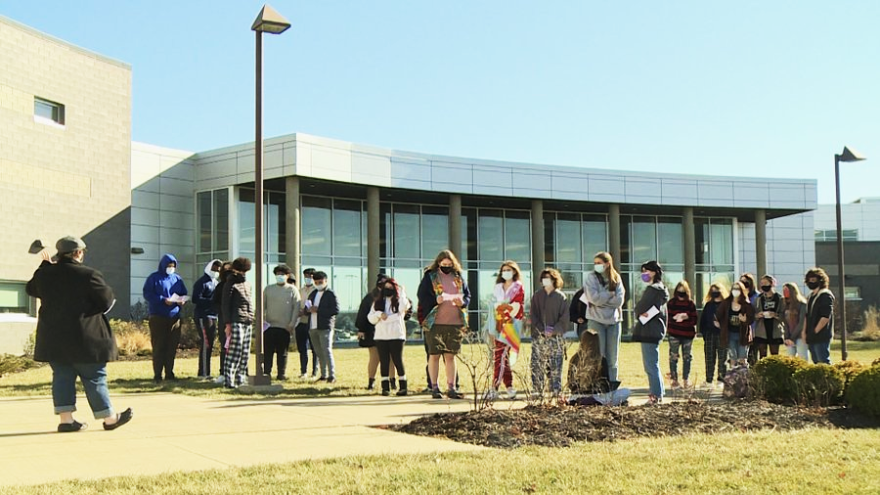For more stories like this one, subscribe to Real Humans on Apple Podcasts, Spotify, Stitcher or wherever you get podcasts.
In December, as Columbia Public Schools headed into winter break, students and teachers got word that they'd be returning — post holiday — without a mask mandate. This was at the height of the omicron variant surge, and Quinn Felts, a sophomore at Hickman High School, got an uneasy feeling that stuck with him through the break.
The 15-year-old has never known high school to be what's often invoked as "normal." When the COVID-19 pandemic began, he was still in eighth grade.
The last time he left his middle school building, he didn't realize he was leaving for good.
"I didn't even say goodbye to any of my teachers," Felts recalls. "They said it was going to be a two-week break."
He spent a lonely summer distanced from friends, before his high school career began in hybrid mode: partially online, partially in person.
"We kind of alternated days," Felts explains. "Like, a group of people would go Monday, and then another group of people would go Wednesday, and then we'd go back Friday. So in between those days they could sanitize."
But every day on campus was a mask day.
"Everybody knew we needed to do that," he says, remembering how masking in school once felt like a no-brainer.
Over winter break, after the new policy was announced, case counts began to soar. Felts expected the district to backtrack.
"I thought like two days before school started again, they were gonna be like, 'OK, spike in cases, you know, masks are back,'" he says. "But that didn't happen. So then I was like, 'OK, we need to kind of like do something.'"
When the possibility of organizing a walkout flashed through his mind, Felts texted a friend, unsure of the idea. The friend immediately texted back: that could actually work. Felts says he mentioned it to a teacher, too.
"I was like, 'Do you think some sort of boycott would work?' And she said, 'If you got enough people, I 100% believe that it would work.'"

What they were up against, however, was bigger than a local school board decision. The change in policy had occurred under significant pressure from Missouri Attorney General Eric Schmitt.
In late November, a Cole County judge ruled that a Missouri Health Department policy empowering local health departments to issue public health "control measures" had been unconstitutional. Schmitt attempted to apply the ruling to Missouri school districts, ordering them to halt all mask and quarantine mandates immediately.
Schmitt, who'd already filed a lawsuit against Columbia Public Schools earlier in the year, wrote letters to districts in St. Louis, Columbia and Kansas City and others warning of consequences for non-compliance.
"My office will enforce the court’s order across the state," Schmitt wrote.
In this high-stakes political climate, Felts and a growing network of fellow organizers started handing out fliers to classmates during passing periods in high school hallways. The flier gave a rundown of active case numbers in Boone County as of Jan. 5 (1,478), and in Hickman High School as of the semester's second day (46).
"It is clear that in order to keep schools open, students and staff must be required to wear masks," the flier said, followed by details for anyone wishing to participate.
The original idea was to get lots of people to walk out on a Monday at noon and not come back until the mask mandate was back in place.
Felts now considers that approach "extreme." The protesters decided to start small, with a 15-minute walkout to kick things off, adding five minutes a day until their demands had been met.
It took less than a week.
"We started on a Monday," Felts told me when we first spoke, about two weeks ago. "By Friday, they had brought back the mandate."
The mandate was temporary, set to expire again Feb. 4, but it was a start.
Felts got the good news from his mom. He said having this safety measure restored brought a sense of relief.
"There was a feeling of hopelessness, because it just felt like, everybody at at my age kind of feels like a kid. They can't really do anything about anything, you know? They just have to sit back and let whatever happens happen."

That sentiment connects Felts and his classmates to a whole movement of high school walkouts in the United States. Generations of fed-up students have come to the same conclusions as the teens at Columbia's Hickman High School, and their walkouts have prompted significant change. So says historian Dawson Barrett, author of "Teenage Rebels: Successful High School Activists From the Little Rock Nine to the Class of Tomorrow."
"On paper, high school students have effectively no power," Barrett explains. "They have to listen to their parents and to their teachers. Many of them have to listen to their bosses. And then of course, they can't vote. That's really the big reason that walkouts are such a popular tactic for students. They're expected to sit at their desks. The one form of rebellion they have is to get up and walk out."
Student walkouts have inspired change so enduring and pervasive we now take it for granted. Until the 1970s, Barrett says, American schools required boys to wear their hair short and girls to come to school in dresses.
"Those were the rules," he notes. "On the whole that's different today, and that's not because society magically changed, but because countless high school students organized protests and received detentions and suspensions for challenging those rules."
Just four years ago, national school walkouts in response to a shooting at Marjorie Stoneman Douglas High School in Parkland, Florida, took on the NRA. "The NRA is much worse off than it was five years ago," Barrett says. "I think you have to acknowledge that high school students are at least some part of that."
Student protest movements are bubbling up in high schools in and around Kansas City, even as I write this. On Feb. 10, students at Park Hill High School began a nonviolent protest in the school gymnasium, demanding that a teacher who called a student the n-word be fired. They've vowed not to stop until that happens.
In Wentzville, Missouri, near St. Louis, high school students are suing their school district for banning books — the first lawsuit of its kind filed by the ACLU in response to recent challenges to literature.
Barrett reminds me that it's been less than two years since young people watched and in some cases participated in "probably the most widespread protest in U.S. history." He's talking about the Black Lives Matter uprising in cities and small towns across the country in the summer of 2020. That teens are applying what they learned in a vacuum of adult leadership on the social crises of our times isn't surprising.
The only unusual thing about last month's student walkouts in Missouri is that students at Hickman High School didn't defy the rules. They demanded rules. And their reluctant elders, eventually, succumbed.
The students' quick victory turned out to be short-lived.
Last week, I got a message from Felts letting me know that the district had once again let the mask mandate expire. He’d been confident, before, that if the mandate lapsed again, the students would simply walk out again. But faced with the reality of what felt like defeat, the students became demoralized. Felts told me the overriding sentiment was that it hadn't worked the first time, so why bother.
History proves instructive on this point as well.
Barrett hasn't followed the protests in Missouri all that closely, but he considers them to have been quite successful.
"To have pushed anything to the school board, particularly with the school board having to defy government above them, that's not nothing," Barrett says. "I know why it feels like nothing. I'm a historian so everything is long term. But you live in the present, and everything feels like it's not working."
The story of change favors the historian's perspective: having to fight for the same change more than once is the rule, not the exception.
Barrett defines a successful protest as one that causes people in power to feel pressure. It can be hard to know, in real time, whether that's happened.
"Look at the famous 1960s lunch counter sit-ins," Barrett instructs. "For months, civil rights activists who were mostly high school and college students, they got nothing but beatings and arrests and harassment, and the store owners kept saying over and over that they would never be swayed by protests, that they would never desegregate their lunch counters. But then, after about six months, many of them did desegregate their lunch counters. The students won, but for every day of that campaign, until the last one, it was a loss. So if they had stopped even a day early, we might not know that story that way."
When I ask Barrett what he'd say to the students of Hickman High School about how effective their actions had been, now that the mask mandate in their school has once again been dropped, he makes another point that, to me, feels equally important.
"It isn't just about winning and losing. Right and wrong still matter," he says. "Win or lose, actions matter."






